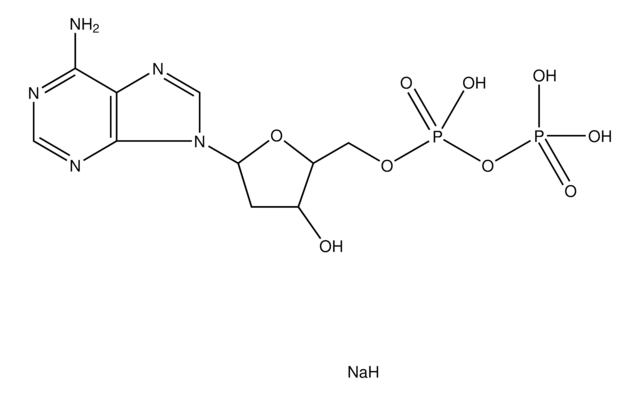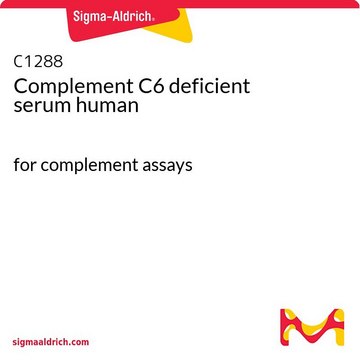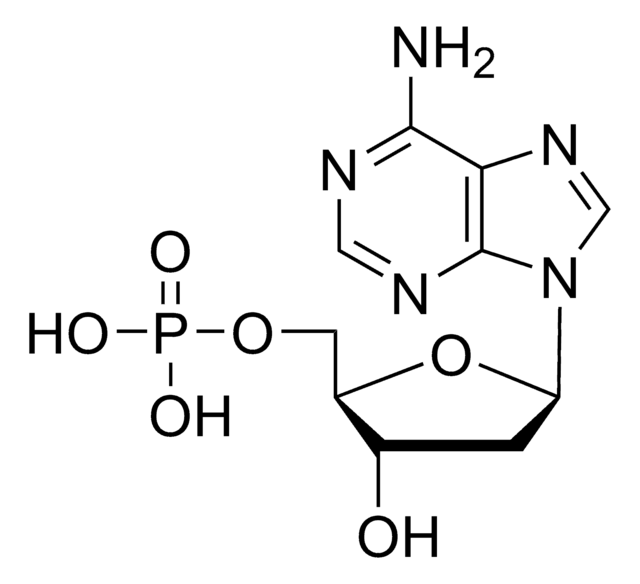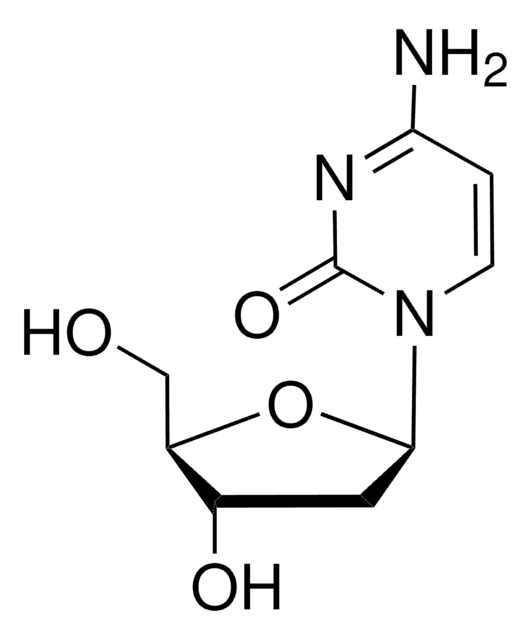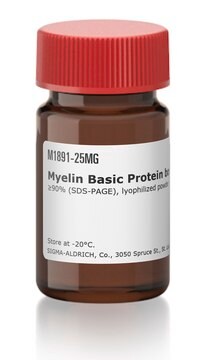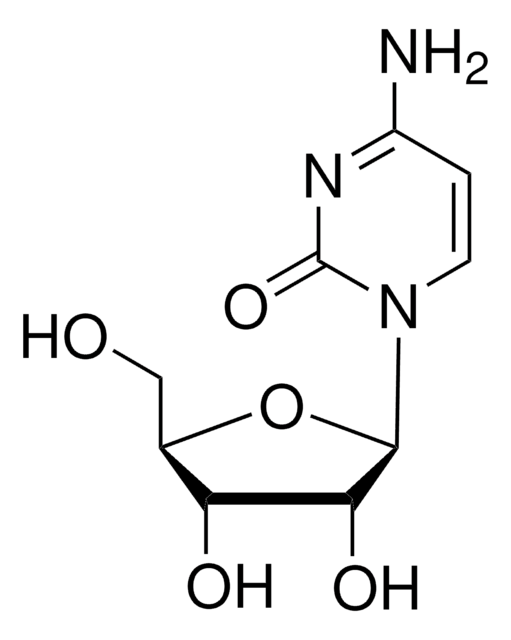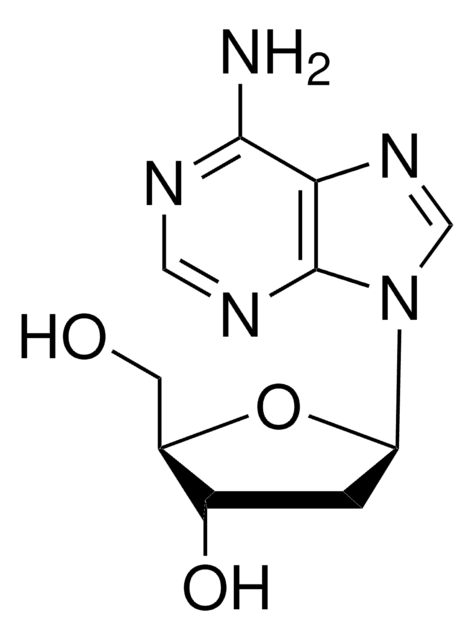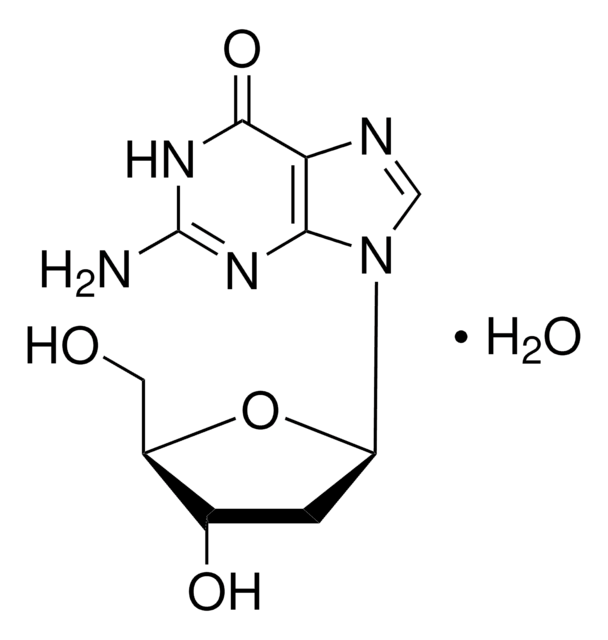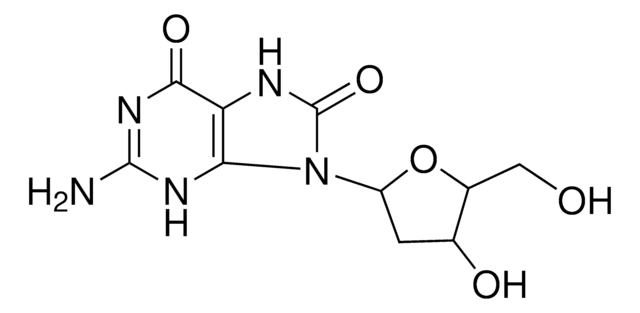D9250
2′-Deoxyguanosine 5′-diphosphate sodium salt
≥90% (HPLC)
Synonym(s):
dGDP
Sign Into View Organizational & Contract Pricing
All Photos(3)
About This Item
Empirical Formula (Hill Notation):
C10H15N5O10P2 · xNa+
CAS Number:
Molecular Weight:
427.20 (free acid basis)
MDL number:
UNSPSC Code:
41106305
PubChem Substance ID:
NACRES:
NA.51
Recommended Products
Quality Level
Assay
≥90% (HPLC)
form
powder
solubility
water: 50 mg/mL, clear, colorless
storage temp.
−20°C
SMILES string
[Na].NC1=NC(=O)c2ncn(C3CC(O)C(COP(O)(=O)OP(O)(O)=O)O3)c2N1
InChI
1S/C10H15N5O10P2.Na.H/c11-10-13-8-7(9(17)14-10)12-3-15(8)6-1-4(16)5(24-6)2-23-27(21,22)25-26(18,19)20;;/h3-6,16H,1-2H2,(H,21,22)(H2,18,19,20)(H3,11,13,14,17);;
InChI key
VLWIICGGBFZYEZ-UHFFFAOYSA-N
Related Categories
General description
2′-Deoxyguanosine 5′-diphosphate (dGDP) is a nucleotide with guanine base, deoxyribose and two phosphate.
Application
2′-Deoxyguanosine 5′-diphosphate (dGDP) is used as a substrate of dGDP (nucleoside diphosphate) kinase (2.7.4.6) or pyruvate kinase to produce dGTP in support of DNA biosynthesis. dGDP is used as a substrate to study the kinetics of glycoprotein (gp) 1.7 expressed by bacteriophage T7.
2′-Deoxyguanosine 5′-diphosphate sodium salt has been used as a xanthosine 5′-monophosphate analog and xanthine phosphoribosyl transferase inhibitor in kinetic studies.
Biochem/physiol Actions
2′-Deoxyguanosine 5′-diphosphate (dGDP) inhibits xanthine phosphoribosyl transferase (XPRT) and hypoxanthine-guanine phosphoribosyl transferase (HGPRT).
Signal Word
Warning
Hazard Statements
Precautionary Statements
Hazard Classifications
Eye Irrit. 2 - Skin Irrit. 2 - STOT SE 3
Target Organs
Respiratory system
Storage Class Code
11 - Combustible Solids
WGK
WGK 3
Personal Protective Equipment
dust mask type N95 (US), Eyeshields, Gloves
Choose from one of the most recent versions:
Already Own This Product?
Find documentation for the products that you have recently purchased in the Document Library.
Customers Also Viewed
Ngoc Q Tran et al.
Molecular microbiology, 77(2), 492-504 (2010-05-26)
Gene 1.7 of bacteriophage T7 confers sensitivity of both phage T7 and its host Escherichia coli to dideoxythymidine (ddT). We have purified the product of gene 1.7, gp1.7. It exists in two forms of molecular weight 22,181 and 17,782. Only
Jie Bao et al.
Biotechnology and bioengineering, 89(4), 485-491 (2005-01-12)
The enzyme reaction mechanism and kinetics for biosyntheses of deoxyadenosine triphosphate (dATP) and deoxyguanosine triphosphate (dGTP) from the corresponding deoxyadenosine diphosphate (dADP) and deoxyguanosine diphosphate (dGDP) catalyzed by pyruvate kinase were studied. A kinetic model for this synthetic reaction was
Jiande Gu et al.
Nucleic acids research, 35(15), 5165-5172 (2007-07-31)
The 2'-deoxyguanosine-3',5'-diphosphate, 2'-deoxyadenosine-3',5'-diphosphate, 2'-deoxycytidine-3',5'-diphosphate and 2'-deoxythymidine-3',5'-diphosphate systems are the smallest units of a DNA single strand. Exploring these comprehensive subunits with reliable density functional methods enables one to approach reasonable predictions of the properties of DNA single strands. With these
Ngoc Q Tran et al.
Proceedings of the National Academy of Sciences of the United States of America, 105(27), 9373-9378 (2008-07-05)
Bacteriophage T7 DNA polymerase efficiently incorporates dideoxynucleotides into DNA, resulting in chain termination. Dideoxythymidine (ddT) present in the medium at levels not toxic to Escherichia coli inhibits phage T7. We isolated 95 T7 phage mutants that were resistant to ddT.
Bhumi Patel et al.
Biochimica et biophysica acta. Proteins and proteomics, 1866(3), 426-441 (2017-12-14)
Among all PRT enzymes of purine salvage pathway in Leishmania, XPRT (Xanthine phosphoribosyl transferase) is unique in its substrate specificity and their non-existence in human. It is an interesting protein not only for drug designing but also to understand the
Our team of scientists has experience in all areas of research including Life Science, Material Science, Chemical Synthesis, Chromatography, Analytical and many others.
Contact Technical Service